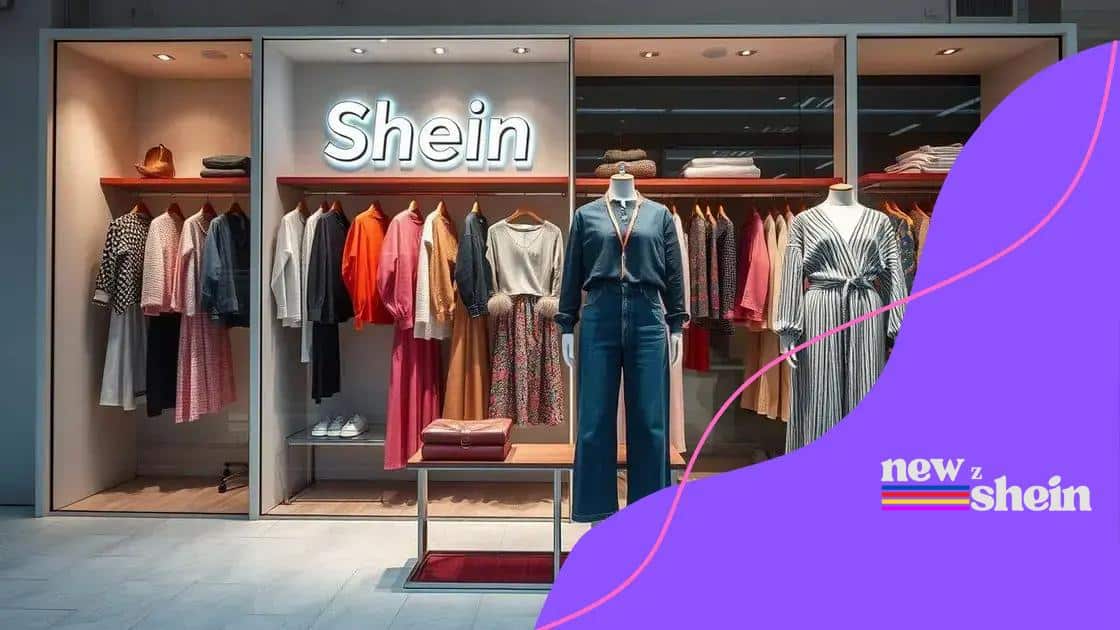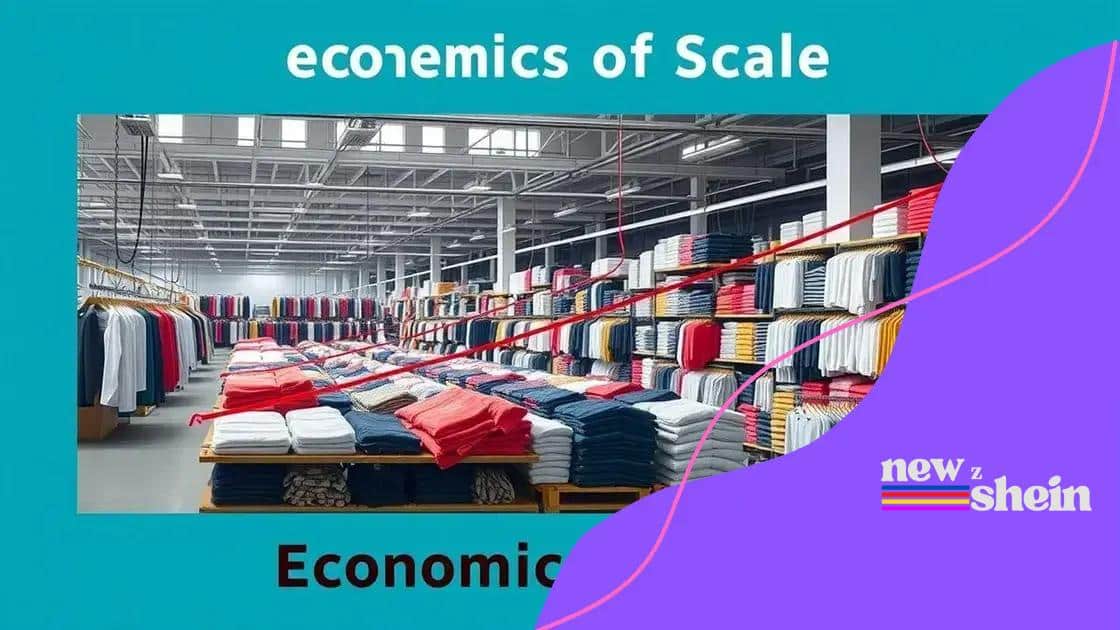How Shein keeps prices affordable worldwide

Shein keeps prices affordable worldwide by leveraging global sourcing, economies of scale, advanced technology, and dynamic marketing strategies while navigating challenges like competition and changing consumer preferences.
How Shein keeps prices affordable worldwide is a question many fashion lovers ponder. With trendy styles at unbeatable prices, it’s remarkable how they manage these costs. Let’s dive into the strategies behind this fashion giant’s pricing success.
The role of global sourcing in pricing
The role of global sourcing in pricing is crucial for Shein. By sourcing materials and products globally, Shein can minimize costs effectively. This strategy enables them to offer trendy clothing at prices that appeal to a vast audience.
One way Shein maximizes savings is through partnerships with manufacturers across various countries. These strategic relationships help in tapping into lower labor costs and competitive material rates. The diverse supply chain allows Shein to remain agile and adjust to changes in demand quickly.
Key Benefits of Global Sourcing
- Cost Efficiency: Access to lower costs in different regions helps reduce overall expenses.
- Variety of Options: Sourcing from multiple locations provides a broader range of materials and styles.
- Faster Turnaround: A global network can speed up production and delivery times, keeping up with fashion trends.
Moreover, Shein uses technology to enhance communication with suppliers. This streamlined process ensures that they can react to fashion trends without extensive delays. The integration of technology bridges geographical gaps, making it easier to maintain quality and efficiency.
In conclusion, global sourcing is a significant component that allows Shein to maintain low prices while delivering a diverse selection of apparel. This approach not only supports competitive pricing but also strengthens the brand’s market position.
How technology aids in maintaining low costs
Technology plays a vital role in how Shein maintains low costs while producing fashionable clothing. By leveraging advanced technologies, Shein optimizes its operations and enhances efficiency, contributing to affordable pricing.
One significant aspect is the use of data analytics. Analyzing trends and customer preferences helps Shein stock the right items at the right time. This minimizes excess inventory, reducing storage costs and allowing for better resource allocation.
Automation in Production
Additionally, automation in manufacturing processes has transformed the fashion industry. Shein invests in automated production lines, which speeds up manufacturing and reduces labor costs. These technological advancements not only increase output but also maintain high-quality standards.
- Reduced Labor Costs: Automation decreases the need for manual labor.
- Faster Production Times: Machines can produce items quicker than human workers.
- Consistent Quality: Automated systems provide uniformity in production.
Moreover, Shein employs innovative supply chain management tools. These tools improve communication and logistics, as well as ensure that materials are sourced efficiently. The real-time tracking of shipments further reduces delays and associated costs.
In conclusion, technology is essential for Shein to keep costs low. From data analytics driving purchasing decisions to automation in production and efficient supply chain management, these elements create a streamlined process that ultimately benefits consumers by keeping prices down.
The impact of economies of scale on pricing

The impact of economies of scale on pricing is significant for Shein. By producing large quantities of clothing, Shein can lower the cost per unit, which translates to lower prices for customers.
One of the main advantages of economies of scale is the ability to negotiate better prices with suppliers. When Shein buys materials in bulk, suppliers often offer discounts, which helps reduce overall production costs. This strategy allows Shein to pass savings on to shoppers.
Benefits of Economies of Scale
There are several benefits when a company like Shein achieves economies of scale:
- Lower Costs: Large production allows for more efficient use of resources.
- Increased Bargaining Power: Buying in bulk can lead to lower prices from suppliers.
- Product Variety: Savings from large-scale production can fund a wider range of products.
As Shein grows, it can produce even more at lower costs. This cycle creates a competitive advantage, as lower prices attract more customers. The brand’s ability to scale quickly has positioned it as a leader in the fast fashion industry.
In addition, economies of scale help Shein streamline its operations. Efficient manufacturing and logistics reduce waste and improve speed. This efficiency means that Shein can quickly respond to changing market trends while keeping costs manageable.
Marketing strategies that keep prices low
Marketing strategies play a crucial role in how Shein keeps prices low while attracting customers. By focusing on smart marketing tactics, Shein can effectively promote its products and maintain affordability.
One of the core strategies is leveraging social media. By utilizing platforms like Instagram and TikTok, Shein reaches a vast audience without spending heavily on traditional advertising. Engaging influencer partnerships also contribute to brand visibility, creating a buzz around their latest collections.
Direct-to-Consumer Approach
Shein has implemented a direct-to-consumer model that reduces costs. This approach eliminates the need for middlemen, allowing them to offer better prices. Customers benefit from lower prices since the brand can control the entire process, from design to delivery.
- Elimination of Markups: Selling directly cuts out additional costs associated with retailers.
- Enhanced Customer Feedback: Communication with end-users helps tailor products to consumer preferences.
- Frequent Promotions: Direct interaction allows for agile marketing, leading to quick promotional offers.
Moreover, Shein constantly analyzes market trends. By keeping a close eye on consumer preferences, they can adjust their inventory swiftly. This responsiveness minimizes waste and ensures that popular items remain in stock, helping maintain low prices.
Additionally, user-generated content plays a significant role in their marketing strategy. By encouraging customers to share their looks, Shein creates a community that enhances brand loyalty. This organic promotion keeps marketing costs lower, leading to further savings for consumers.
Challenges faced in pricing strategy
Shein faces several challenges in its pricing strategy that impact how it offers affordable fashion. One major challenge is the ever-changing nature of the fashion industry. Trends can shift rapidly, which means Shein must constantly adjust its prices and inventory to meet customer demand.
Another difficulty arises from competition. Numerous fast fashion retailers are emerging globally, putting pressure on Shein to maintain its competitive edge. If prices are too high, customers may turn to alternatives. Therefore, Shein needs to balance affordability with quality to attract and keep buyers.
Global Economic Factors
Additionally, global economic factors can influence pricing strategies. Fluctuations in currency exchange rates and shipping costs can affect how much Shein spends to source materials and manufacture clothing.
- Import Tariffs: Tariffs can increase costs for imported products, forcing Shein to adjust prices.
- Sourcing Challenges: Issues in obtaining materials or manufacturing can lead to delays and higher costs.
- Labor Regulations: Changes in labor laws may impact production costs, affecting final pricing.
Customer expectations also pose a challenge. Consumers increasingly demand transparency regarding pricing and ethical sourcing. This trend can compel Shein to adjust its strategies to maintain customer trust and satisfaction. By clearly communicating their pricing practices, they can foster a more loyal customer base.
Finally, managing inventory efficiently is crucial. Overproduction can lead to excess stock, requiring Shein to lower prices significantly to clear out old merchandise. Striking the right balance between supply and demand is essential for maximizing profits while keeping prices down.
In conclusion, Shein’s success in keeping prices low stems from a combination of effective global sourcing, innovative technology, strategic marketing, and the ability to navigate challenges in the fashion industry. While they effectively lower costs through economies of scale, their pricing strategy must adapt to market demands and economic factors. By understanding customer needs and responding quickly, Shein manages to offer fashionable clothing at competitive prices, while still facing challenges from competition and market dynamics.
FAQ – Frequently Asked Questions about Shein’s Pricing Strategies
How does Shein keep prices low?
Shein keeps prices low through global sourcing, economies of scale, and leveraging technology to streamline operations.
What marketing strategies does Shein use?
Shein utilizes social media and influencer partnerships to reach a wider audience at a lower advertising cost.
What challenges does Shein face in pricing?
Shein faces challenges like competition, changing fashion trends, and global economic factors that can impact pricing strategies.
How does Shein adapt to customer preferences?
Shein collects customer feedback and monitors market trends to quickly adjust inventory and pricing to meet consumer needs.





